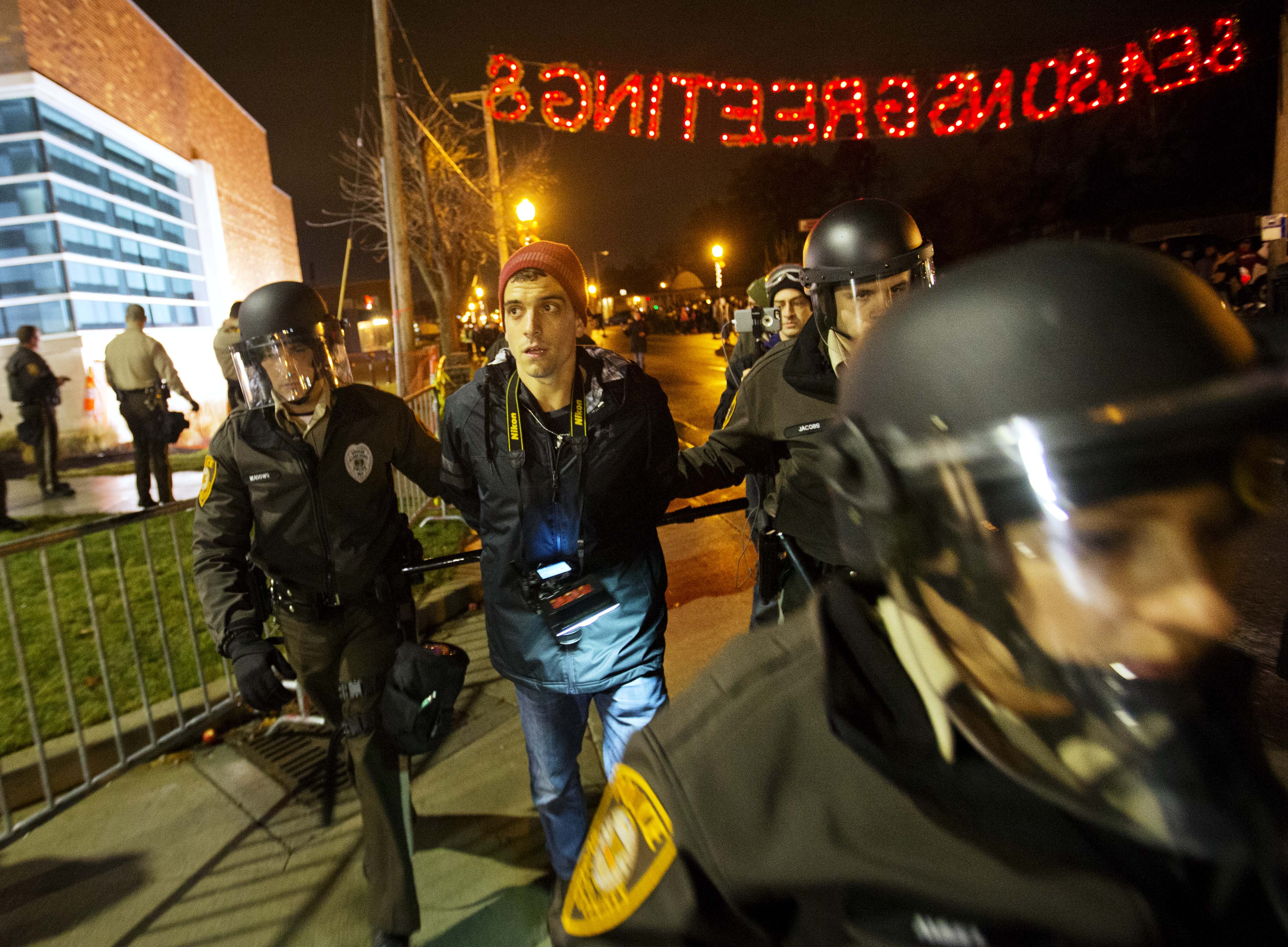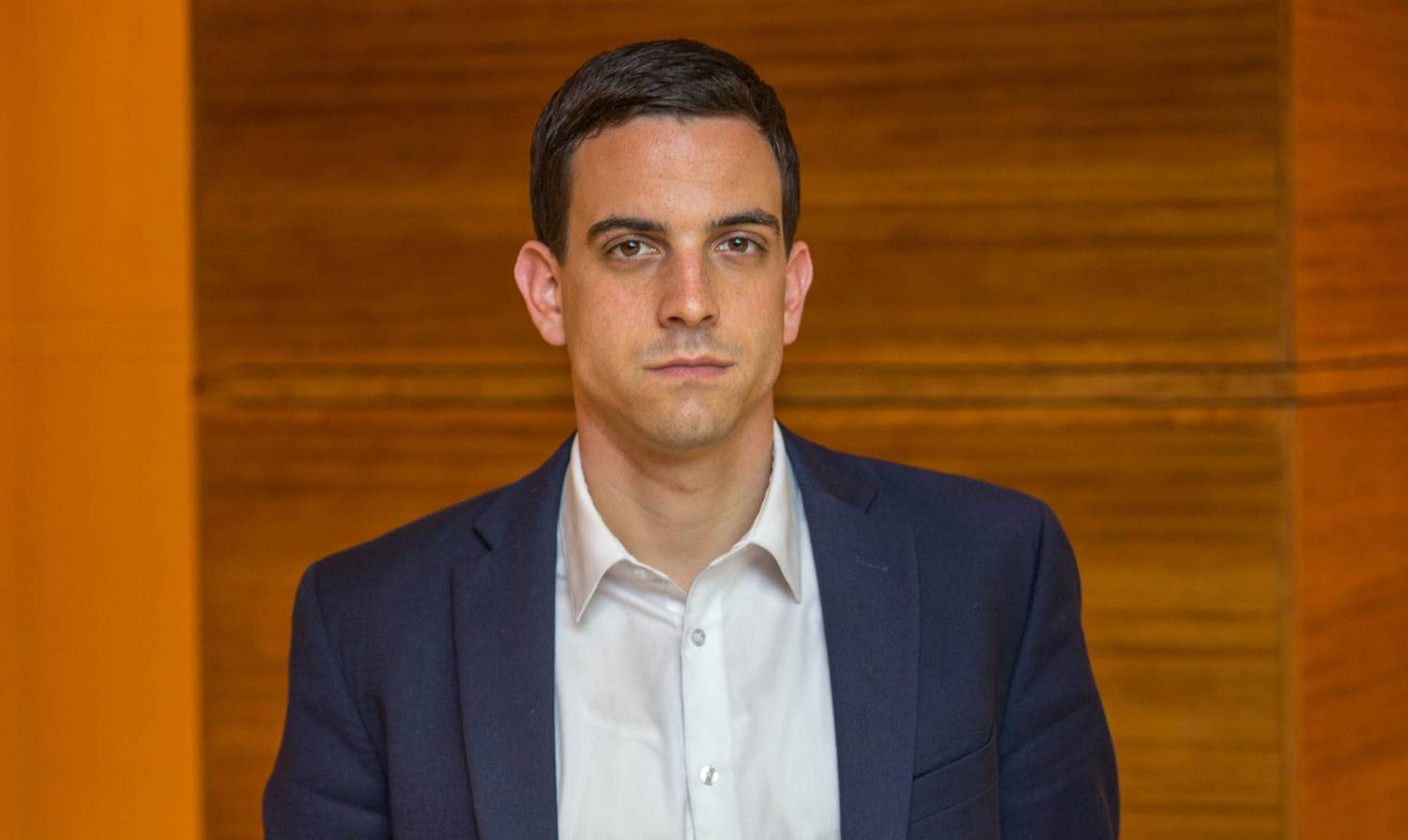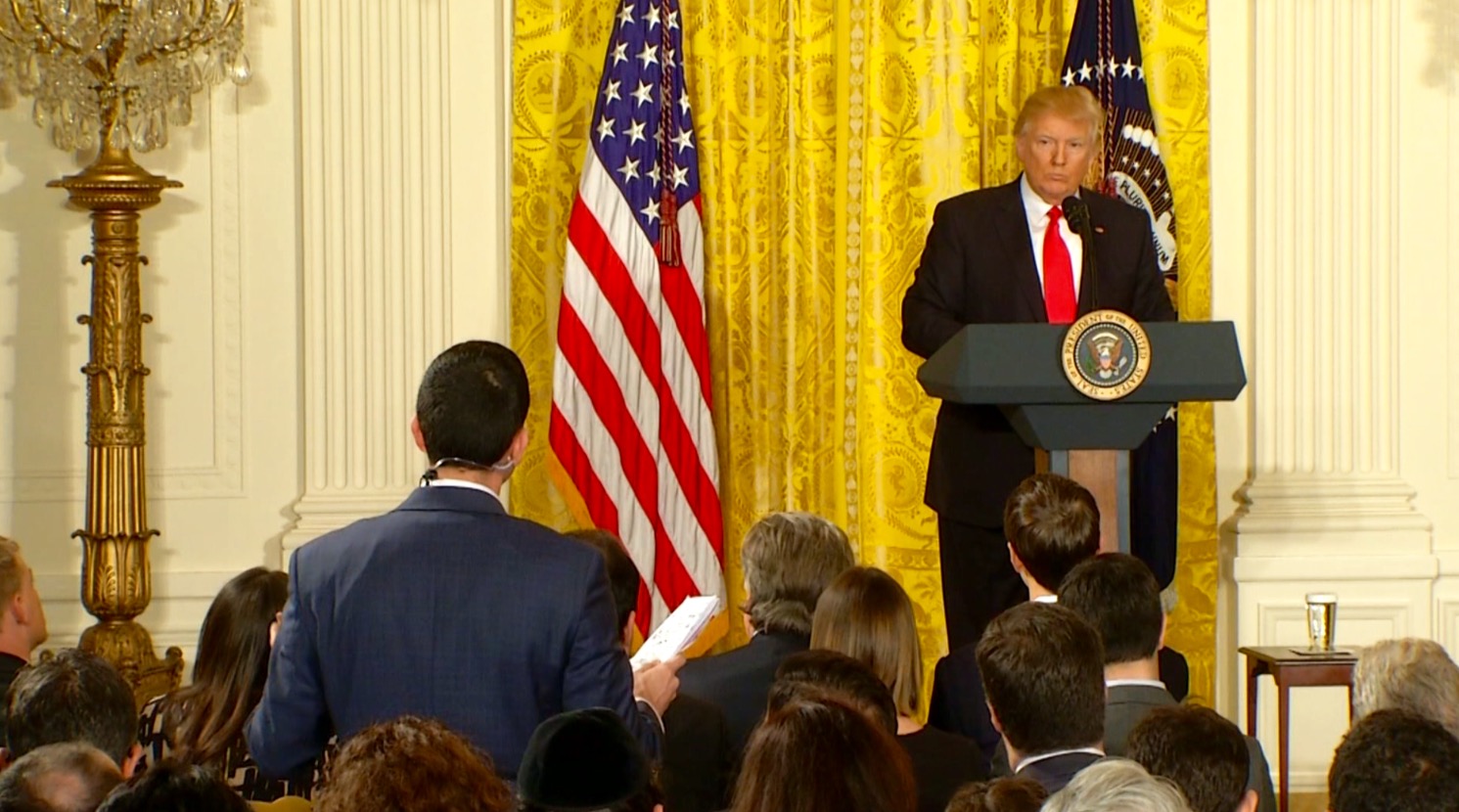Trey Yingst was born during the Clinton administration, and he’s covering Trump’s.
When the White House holds press briefings, the 23-year-old is often among the youngest people in the room. He stands alongside veterans such as Glenn Thrush, April Ryan and Jim Acosta as they all try to wrangle answers out of Press Secretary Sarah Huckabee Sanders. Yingst frequently does.
And he works for one of the most conservative news organizations in the White House press corps.
Yingst is the chief White House correspondent for One America News Network, which launched in summer 2013 with the goal of targeting a right-wing audience — one OANN President Charles Herring said was underserved by Fox News.
And for the past few years, OANN, which says it reaches about 35 million homes in 35 states, has come under substantial fire for what some say is biased coverage of the Trump administration. The Washington Post has described the network’s two-hour block of evening opinion shows as “guns-blazing nightly tributes to Trump,” and The Anniston Star — a newspaper in rural Alabama — recently published an editorial with the headline “If you like Fox News, you’ll love One America News.”
Herring disputes the notion that OANN is partisan.
“With 21 hours of live news a day and anchors not allowed to express their point of view, our viewers understand and appreciate our mission,” he told Poynter in an email. “We don’t always get it right, but we strive.”
At the very least, Yingst strives — OANN’s political leanings haven’t stopped him from committing unbiased political journalism.
While the president of the United States openly mocks the press, his advisers offer “alternative facts” and press secretaries avoid answering questions at all costs, Yingst demands answers. In press briefings, he frequently gets Huckabee Sanders and — before he resigned — Sean Spicer to address topics they deemed off-limits only minutes beforehand, often opening up new lines of inquiry for other reporters.
Yingst’s knack for getting people to talk is obvious. In videos of previous White House press briefings — one before the recording blackout began earlier this summer — the reporter stands out among the rest of the corps, even though he stands in the back. He frequently asks follow-ups, never cracking a smile. He’s a steady bulwark against the backdrop of an often chaotic White House communications team.
Yingst has been that way for years.
“My job as a journalist isn’t to ask softball questions, he said. “My job as a journalist is to ask tough questions.”
‘It’s certainly a shift’
Trey Yingst was 21 years old when he was arrested while doing his job.
He had cut class at American University to cover the protests and riots in Ferguson, Missouri, following the shooting of Michael Brown. He was standing on a sidewalk, getting quotes, photos and video two days before the grand jury decision to not indict Darren Wilson — the officer who shot and killed Brown — when a police officer hollered at him.
He was going to jail.
“As a journalist in general, it was concerning because you like to think your First Amendment rights will always be protected, and in that instance mine weren’t,” said Yingst, whose charges were dropped after spending a night in jail. “Sitting in the back of that police van, there was a moment when I thought to myself, ‘If this can happen to me, there is a much larger story to be told here in Ferguson.’”

Journalist Trey Yingst is arrested during a demonstration outside the Ferguson Police Department, Sunday, Nov. 23, 2014, in Ferguson, Mo. (AP Photo/David Goldman)
That story is about the essential role of the free press during moments of trauma in America and beyond. And in the aftermath of a white nationalist rally in Charlottesville, Virginia, last weekend that left three dead and dozens injured, the media’s role is more important now than ever.
“The events that happened in Charlottesville are a reminder that things haven’t necessarily gotten better since Ferguson in 2014,” Yingst said. “The way that we talk about the relationship between the media and law enforcement and administration — all these conversations are still being had.”
It’s a conversation that he has spent the majority of his short journalism career trying to have.
Yingst, who graduated with a 3.9 GPA in spring 2016, is no stranger to conflict zones — he sometimes skipped class (with blessings from his broadcast journalism professors) to cover them. He once missed his final exams to report on riots in Baltimore after the death of Freddie Gray. He covered major conflicts across the world, from Missouri to Uganda. During his senior year, the Harrisburg, Pennsylvania, native was the youngest credentialed member of the press to cover fighting along the Gaza Strip, Poynter previously reported. His work appeared on NBC, ABC, CBS, Fox and CNN, and in The New York Times and The Washington Post.
Some of Yingst’s success in college is owed to News2Share — a news site he co-founded with Ford Fischer to publish on-scene photos, videos and stories from conflict zones. The aim was to build a more participatory news cycle by soliciting photos and videos from citizen journalists, which then could be sold to major news networks.
Raw, on-scene reporting is a key interest for Yingst. In 2014, he gave a TEDx talk at American titled “The Fourth Estate Through the First Person” that focused on how citizen journalists can play an important role by reporting from conflict zones.
“(Audiences) don’t have to rely on the reporter who’s standing 50 feet away from the event. They don’t have to rely on that news helicopter that’s flying around telling you to care about that little speck that’s supposed to be a car accident,” he said during the talk. “(Through bystander videos) you can see the human suffering up close and thus you can feel emotion for it. You can care about it more.”
He recently sold his stake in News2Share, which is still telling “stories about race and tension in our country” under Fischer’s management, Yingst said. In retrospect, all of that work during his years at American wasn’t anything out of the ordinary for Yingst — it was just part of his job as a budding reporter.
“For me, age — and this is a bit of a cliche — age really is just the number,” he said. “If you go in every day with the same mindset … it doesn’t matter how young you are.”
Yingst has taken that mindset from the classroom to Washington, where he regularly interviews politicians and appears on national television. Although he had previously received day passes to cover the White House, the move has been a dramatic change for Yingst, who graduated only weeks before Trump became the Republican nominee.
“Last year, I was in college. This year, I’m asking questions on national television,” he said. “It’s certainly a shift.”
After graduating from American, Yingst wanted to be on TV — he didn’t want to start in a local market and later go national. That’s when he discovered OANN, a smaller network than the giants of Fox News, CNN and MSNBC.
He applied for a position with the network in spring 2016. After getting a call around graduation, Yingst flew to San Diego to interview with OANN leadership, and was later offered a job. For Yingst, it was perfect.
“For me, I wanted to be on air right away — and they let me,” he said. “I think they will often give me opportunities that if I was somewhere else, I might be a production assistant or reading over scripts.”
He started his first job at OANN in June, covering international conflict from D.C. Yingst said his transition to covering the White House “sort of just came about” near the end of the Obama administration, when the network was expanding and looking to bulk up its coverage of national politics. He was in the right place at the right time.
And for someone who’s been covering the White House for less than a year, Yingst is already getting the hang of it. He regularly appears on OANN’s nightly news programming, doing standups at and around 1600 Pennsylvania Avenue about everything from the implications of Trump’s tweet de jour to the geopolitical situation in Raqqa, Syria. His interactions in the press room have been featured on “Last Week Tonight” with John Oliver and “The Late Show” with Stephen Colbert.
Before Trump was inaugurated, Yingst was trying to get ahead in the Washington press scrum. He introduced himself to Spicer during the transition — a move that proved beneficial when it came time for briefings.
Yingst said he gets called on almost every day at press briefings, and while some might argue that’s because he works for a conservative network, he doesn’t think he has an unfair advantage. He said he just focuses on asking good questions.
“I don’t know why I get called on every day by Sean,” Yingst said in July, before Spicer resigned as White House Press secretary. “My guess would be I’m a nice guy, I go in there, I work hard everyday … the large majority of my job has nothing to do with where I work.”
“Trey gets called on a whole lot when he’s just standing in the aisle,” said Andrew Marantz, a contributing editor for The New Yorker who has written extensively about the press corps. “Sean knows his name, which especially toward the beginning was a really big deal. Trey would always stay in the same spot and has memorable name for Sean.”
Over the next few weeks, the White House will likely revise its press strategy following the exchange of former Communications Director Anthony Scaramucci for interim director Hope Hicks, as well as Spicer for Huckabee Sanders. But to Yingst, developing a devoted network of sources in and around Capitol Hill is more important than playing favorites with the revolving White House communications team.
“I have sources on the Hill who are Democrats and Republicans,” he said. “Building sources is much more about relationships and who you are as a person than it is about where you work.”
‘Old-fashioned, objective journalism’
It’s no secret where OANN falls on the political spectrum.
The network has has been a corporate sponsor of the Conservative Political Action Conference — an annual gathering of right-wing politicians and and supporters — for several years, according to The Washington Post. When Bill O’Reilly was fired at Fox News in April amid sexual assault allegations, OANN was one of the first outlets to consider hiring him. Media Matters has called the network a “right-wing outlet shilling for Trump” and Newsweek once labeled Yingst a “fake journalist” who helped Spicer “spin the news.”
Yingst understands where that criticism is coming from. He knows that people may think his coverage is biased just because he works for OANN. But he doesn’t.
“A lot of people ask me that — ‘You work at this network, but you’re asking these questions,'” he said. “I think it’s important to get the administration on the record. From my perspective, there are 75 to 100 journalists in that room, and I can only be responsible for myself.”
When asked about his own political orientation, Yingst balked at the suggestion that his views might align with those of a party.
“I’m a registered independent and don’t think it’s appropriate to have public views/opinions on issues I report about,” he told Poynter in an email.
Marantz has been critical of the growing right-wing presence in the White House press corps, such as the inclusion of outlets like LifeZette, Townhall and OANN. But he said Yingst is by all accounts a good political reporter — despite working for a conservative news network.
“OANN is obviously much newer and more tacitly admits its political orientation,” Marantz said. “And yet personally he seems really devoted to old-fashioned, objective journalism from all the conversations I’ve had with him. That seems to be really important to him.”
On more than one occasion, Yingst has grilled Spicer and Huckabee Sanders. He’s aggressively questioned Trump’s belief in climate change, whether or not the White House considers Bashar al-Assad a war criminal and who the president consulted with before firing former FBI Director James Comey.
When he doesn’t get answers, Yingst’s questions often lead to weeks of follow-ups by both the administration and the media. In early July, he asked Spicer during a press briefing whether or not the U.S. would sign new sanctions against Russia. That question figured into the international news cycle for a week.
“It occurred to me that we still haven’t gotten a clear answer from the president,” Yingst said. “We don’t know for certain if he thinks Russia interferes (in American politics). I wrote that question down along with five or six others, brought it up and started a conversation.”
Hunter Walker, a White House correspondent for Yahoo News, said the OANN reporter regularly asks some of the best questions during briefings.
“I have heard conversations with other reporters talking about how surprised they are that someone who’s working for an outlet that’s supposed to be so partisan is asking such good questions,” he said. “When someone asks a question in one of these public settings that makes your head turn, that’s really memorable.”
And Yingst has turned plenty of heads. Walker said two of the reporter’s most notable questions have gotten the White House on the record about some of the biggest controversies surrounding the president: Russia and Trump’s tweets.
In February, Yingst asked Trump whether or not members of his administration had any contact with Russian officials or intelligence during the election. The president denied the allegations, despite a New York Times story confirming those contacts based on four anonymous sources.
“That has been cited in countless articles,” Walker said. “That was a really, really sharp question.”
In early June, Yingst got Spicer to say that Trump’s tweets should be considered official White House statements. And now, after the president has openly supported Confederate monuments on Twitter following the events in Charlottesville, that answer is still of lasting importance to the press corps, Walker said.
“We can read that as an official statement from the White House, thanks to Trey,” he said. “When I see a reporter at a partisan outlet asking tough questions and doing good reporting, I have to assume one of two things is happening — either the reporter is fighting the good fight with their editors, or the outlet is more open-minded and objective with its coverage than something you would think. I would say that his work is clearly a credit to him, his network or both.”
But just because Yingst asks good questions and works for OANN doesn’t mean he’s grown indifferent to the constant anti-media remarks coming out of the White House. Both journalists and White House officials can do better, Yingst said.
“When it comes down to it, all these journalists — despite you seeing them on TV — they’re humans,” Yingst said. “And the same goes for the White House officials. My goals every day are to go in, be respectful, be fair, give people an opportunity to respond and ask questions that people want answered.”
Despite the high-profile nature of his reporting, Yingst said he actually doesn’t really like Washington. He prefers conflict zones to the never-ending conflict of D.C. politics. And someday he’d like to return there.
“Going to conflict zones around the world, people are much more raw in their expressions and conversations when they don’t have an agenda to sell you,” he said. “Some of the conversations I was able to do on the streets of Ferguson are substantially different than the conversations I have in Washington, for one reason: those people don’t have anything to sell me … many relationships in the White House are relations of transaction. I prefer to develop a more human relationship to people.”
But no matter where Yingst ends up — whether he stays in the White House press corps or goes abroad to report on international crises — one thing will stay the same.
“I think no matter where I am in life or what I’m covering, I think I’m always going to approach the craft of journalism in the same way,” he said. “That is: asking questions that are based on realities and facts; making sure my information is sourced well; if I make a mistake, taking credit for that mistake; to keep learning.”








